Two-pipe heating system of a private house: device diagrams + overview of the advantages
Providing heat in the house is the most important task for its owner. It can be solved in various ways, but according to statistics, most of the buildings in our country are heated using a water heating system.
It is the water version that is most effective and practical in our rather harsh climatic conditions. The two-pipe heating system of a private house is considered one of its most popular varieties.
We suggest that you familiarize yourself with the options and technologies for assembling heating with a supply and exhaust coolant line. Information is based on building codes and requirements. For completeness of perception of a difficult topic, the information presented is supplemented by photo selections, visual diagrams, and videos.
The content of the article:
Features of two-pipe heating
Any heating system with liquid coolant includes a closed loop connecting radiators that heat the room and a boiler that heats the coolant.
Everything happens as follows: the liquid, moving through the heat exchanger of the heating device, is heated to a high temperature, after which it enters the radiators, the number of which is determined by the needs of the building.
Here, the liquid gives off heat to the air and gradually cools. Then it returns to the heat exchanger of the heater and the cycle repeats.
As simple as possible, the circulation takes place in a single-tube system, where only one pipe is suitable for each battery. However, in this case, each subsequent battery will receive a coolant that has left the previous one, and, therefore, is cooler.

To eliminate this significant drawback, a more complex two-pipe system was developed.
In this embodiment, two pipes are connected to each radiator:
- The first is the supply through which the coolant enters the battery.
- The second is the “return” discharge or, as the masters say, through which the cooled liquid leaves the device.
Thus, each radiator is equipped with an individually controlled supply of coolant, which makes it possible to organize heating as efficiently as possible.
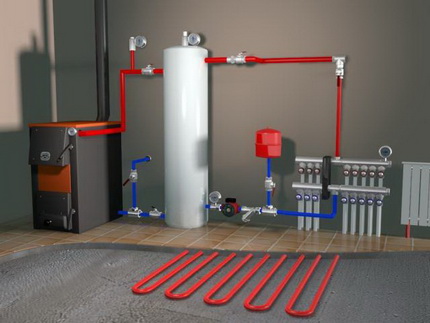
Why choose such a system?
Two-pipe water heating is gradually replacing traditional single pipe designs, since its advantages are obvious and very significant:
- Each of the radiators included in the system receives a coolant with a certain temperature, and for all it is the same.
- Ability to make adjustments for each battery. If desired, the owner can put a thermostat on each of the heating devices, which will allow him to get the desired temperature in the room. At the same time, the heat transfer of the remaining radiators in the building will remain the same.
- Relatively small pressure loss in the system. This makes it possible to use an economical circulating pump of relatively low power for operation in the system.
- If one or even several radiators breaks down, the system can continue to operate. The presence of valves on the supply pipes allows for repair and installation work without stopping it.
- Possibility of installation in a building of any number of floors and area. You only need to choose the best type of two-pipe system.
The disadvantages of such systems are usually attributed to the complexity of installation and the large, in comparison with single-tube structures, cost. This is due to the double number of pipes that have to be installed.
However, it should be borne in mind that for the arrangement of a two-pipe system, pipes and accessories of a small diameter are used, which gives a certain cost savings.As a result, the cost of the system is not much higher than that of a single-tube analogue, and it gives much more advantages.
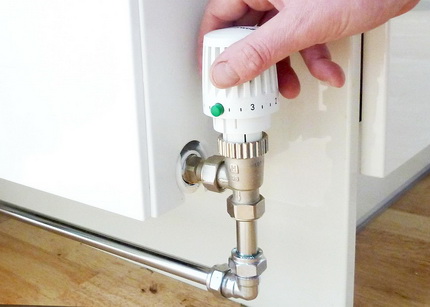
Types of systems with feed and return
The two-pipe design is characterized by many varieties, which can be classified according to various criteria. Consider the main ones.
Open heating
Any hydraulic heating system is a closed circuit, which includes an expansion tank. This element is necessary as the heating fluid increases in volume.
For open wiring a tank is selected that allows the fluid to communicate with the atmosphere. In this case, its part inevitably evaporates, which leads to the need to constantly monitor its level.
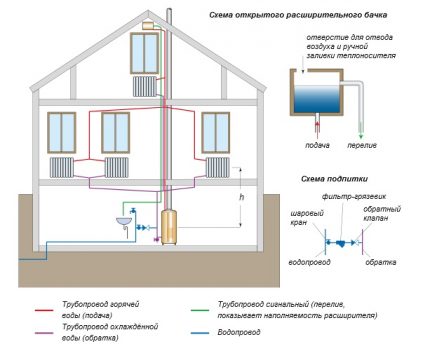
This is a very important nuance, which must be treated very responsibly. Insufficient liquid level in the system leads to the "boiling" of the boiler and its failure. In addition, an open system involves the use of only water as a coolant.
Compounds of glycols or antifreezes, which are more practical in this regard, form toxic fumes during evaporation, therefore they are used only in closed structures.
Closed Circulation System
It differs from the open one by the presence of a closed expansion tank. Does not need constant monitoring by the owner. The design involves installation expansion tank membrane type, which is designed to compensate for a sudden decrease or increase in pressure in the system. Thus, it prevents equipment breakdowns as a result of sudden overloads.
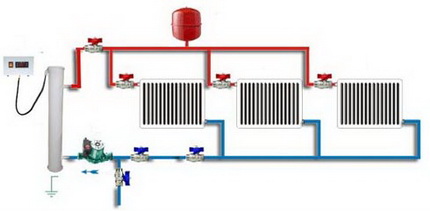
The membrane tank makes it possible to keep the pressure optimal for the pump and boiler in the system. In addition, the closed design allows the use of any suitable fluid in its parameters as a heat carrier.
This makes it possible to obtain the most efficient and economical system with the necessary parameters. For example, not afraid of freezing if it uses antifreeze.
According to the method of circulating the liquid coolant, two-pipe heating systems are divided into two large groups.
Natural circulation design
The basic principle of the system is as follows: the boiler heats the coolant, which expands with increasing temperature. The density of the liquid decreases.
Due to this, colder and therefore dense water gradually displaces the heated liquid up. It rises to the highest point of the system, where it begins to cool down a little and gravity moves into radiators.
In batteries, water gives off the accumulated heat and, cooling further and increasing its density, moves to the boiler. It is obvious that the coolant goes through the whole cycle by gravity, without the use of additional equipment.
Due to the fact that this happens rather slowly, the air displaced by the water manages to move to the peak upper point of the system, which allows you to get rid of excessive airing.
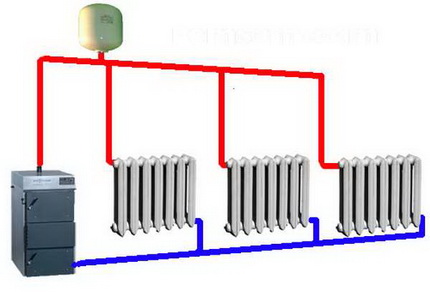
Indisputable advantage natural type constructions considered the long life of her. The absence of moving elements and a circulation pump, as well as the closed loop of the system with a finite amount of mineral salts and suspensions significantly prolongs its operation time.
Experts say that the service life of structures with natural circulation, equipped with polymer pipes and bimetallic radiators can be about fifty years.
The disadvantage of such schemes is considered to be a relatively low pressure drop. It is also necessary to take into account the specific resistance that radiators and pipes exert to the movement of the coolant. Therefore, the radius of action of such a system will be limited. It is recommended that building codes use heating with natural circulation in a radius of no more than 30 m.
In addition, such a system has a fairly high inertia, so a fairly large amount of time passes from the kindling of the boiler and until the temperature stabilizes in the heated building.
A negative point can also be considered that all pipes must be laid under a certain slope so that the fluid can move in the right direction. The natural circulation heating system is capable of self-regulation.
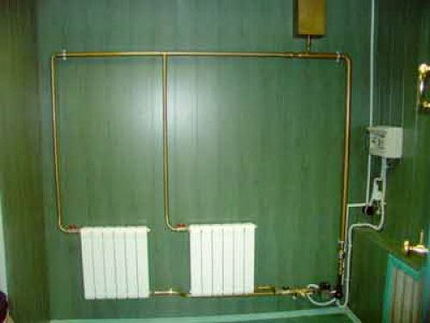
The lower the ambient temperature, the higher the circulation rate of the coolant. In addition, several factors affect the flow of liquid along the heating circuit: the cross-section and material of the wiring pipes, the radius and number of turns in the two-pipe heating scheme of a private house, as well as the presence and type of installed shutoff valves.
By acting on these factors, you can achieve the greatest efficiency of the heating system.
Wiring with forced circulation of the coolant
Included in the above scheme circulation pumpmoving coolant in a closed heating circuit. This provides significant benefits. First of all, the speed of fluid movement increases, due to which the building warms up much faster.
In this case, all radiators connected to the system receive a coolant of approximately the same temperature. This allows them to warm up as evenly as possible.
When using a circuit with natural circulation, this is impossible, since the temperature of the liquid entering the radiator depends on the distance by which it is removed from the boiler. The farther the battery, the colder the coolant. Forced circulation makes it possible to adjust the level of heating of individual network elements. In addition, if necessary, you can overlap its individual sections.
Using a circulation pump allows you to include in the system a membrane expansion tank, that is, to perform it in a closed version. Thus, the amount of vaporized liquid is significantly reduced.
In addition, the installation of the structure is greatly simplified, since there is no need to lay pipes strictly at a certain angle, and accurately calculate their diameter and height.
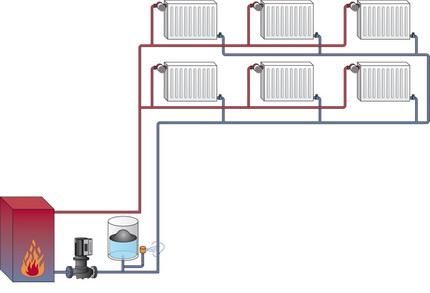
Another advantage forced circulation designs - the ability to quite painlessly make the necessary changes to its layout and layout. To equip such a design, pipes and components of a smaller diameter are used, which significantly reduces its cost.
In addition, such systems are more economical due to the fact that the temperature difference of the liquid coolant at the inlet and at the outlet of the boiler is much smaller than that of the analog with natural circulation.
The presence in the pump circuit prevents the air supply of the heating line. In general, circuits using forced circulation are considered more effective, but they also have drawbacks.
The most significant of these is volatility. The pump cannot operate without being connected to a power source. During power outages, such a heating system stops. With frequent blackouts, it is advisable to have an uninterrupted power source.
The disadvantages usually include financial costs. Some of them are the price of the circulation pump, as well as the cost of fittings, which is necessary for its normal functioning. Which generally increases the cost of installing the system. In addition, monthly bills will be required to pay for electricity, which ensures the operation of the circulation pump.
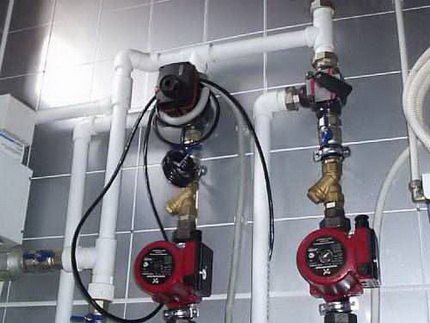
The heating circuit can be arranged in two different ways, which determine the location of the risers and pipelines in space.
Horizontal and vertical layout type
It involves the connection of heating appliances to a horizontal highway. Predominantly mounted in one-story buildings a large area. The risers in this case should be optimally located in the corridors or utility rooms.
The advantage of this type of layout is the lower cost of the system itself and its installation. The main disadvantage is the design's tendency to airing, so the installation of Mayevsky cranes is necessary.
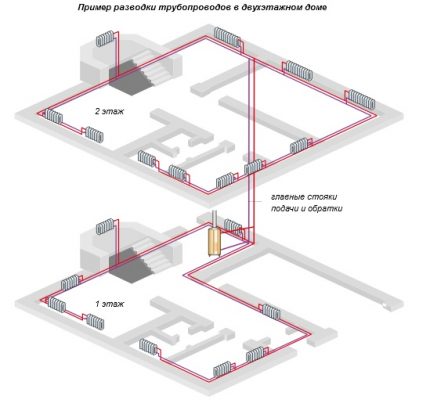
Radiators are connected to vertically located risers. This option is especially good for buildings with several floors, because it makes it possible to connect each floor separately to the heating riser. The main advantage of the system is the absence of air jams. At the same time, arranging a heating circuit with a vertical layout will cost more than for a horizontal analogue.
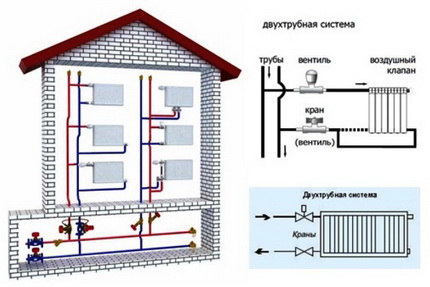
Top-pipe double pipe heating system
The main distinguishing feature of this design is the laying of the supply pipe along the upper part of the room, the return is discharged along its lower part.
An important advantage of such a system is the high pressure in the line, which is due to a significant difference in the levels of the return and supply pipes. Due to this circumstance, their diameter can be the same even when arranging a circuit with natural circulation.
But at the same time, the expansion tank, which is located at the highest point of the circuit, most often ends up in an unheated attic, which can cause problems. Alternatively, you can consider arranging the tank inside the ceiling when its lower half remains in the heated room, and the upper part is displayed in the attic and insulated as much as possible.
If the owner is not particularly concerned about the presence of pipes under the ceiling of the room, it is advisable to place the supply line above the level of the windows.
In this case, the expansion tank can be located under the ceiling, provided that the riser height is sufficient to ensure the normal speed of the coolant. The return line will need to be mounted as close to the floor level as possible or even lowered under it. True, in the latter case, when arranging the highway, it will not be possible to use connecting elements to exclude the appearance of a leak.
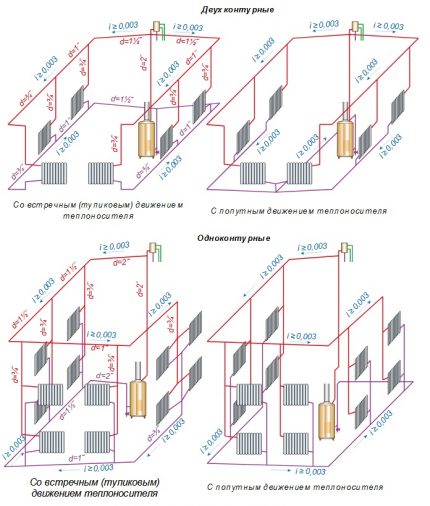
The appearance of the room with pipes laid under the ceiling is not aesthetically pleasing. In addition, part of the heat goes up, which makes the heating system with the upper wiring not efficient enough.
Therefore, you can try to assemble a circuit with a supply line passing under the radiators, but this will only improve the appearance of the system and will not affect its shortcomings.
Connecting the pump allows you to easily achieve optimal pressure in the system, even when using pipes of minimum diameter. The maximum effect of a heating system with a wiring of the upper type can be obtained in a two-story private house, since natural circulation is stimulated by a large difference in the installation height of the boiler in the basement and the batteries of the second floor.
Once again preheated coolant will be sent to the expansion tank, which is placed in the attic or on the second floor. From where on the inclined line the liquid begins to flow into the radiators.
In this case, you can even combine the distribution tank responsible for the availability of hot water and the expansion tank. If a non-volatile boiler is installed in the house, a completely autonomous heating system will be obtained.
Another very successful option for a two-story house is a combined system that combines two and one-pipe sections. For example, a one-pipe construction is mounted on the second floor in the form of a water heated floor, and a two-pipe construction is installed on the first.The ability to control the temperature in all rooms is fully preserved.
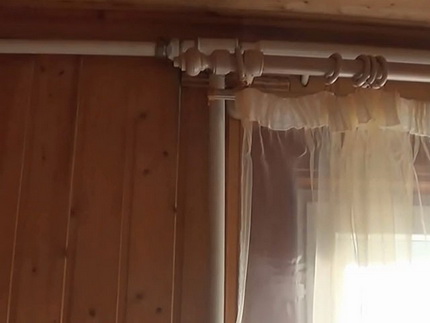
The main advantage of a two-pipe heating system with an upper wiring is considered to be a high speed of advancement of the coolant and the absence of airing of the main.
That is why it is used quite often, without paying attention to significant disadvantages:
- unaesthetic appearance of rooms;
- high consumption of pipes and components;
- the inability to heat large areas;
- problems with the placement of the expansion tank, which can not always be combined with the distribution tank;
- additional decoration costs so that pipes can be masked.
In general, the system with the top wiring is quite viable, and with correctly performed calculations it is also very effective.
Two-pipe design with bottom wiring
The scheme involves mounting the supply and return from the bottom of the batteries. Unlike the system with the upper type of wiring, the direction of movement of the coolant is changed here. It starts moving from the bottom up, passes through the batteries and is sent along the return to the boiler.
Bottom wiring systems may include one or more loops. In addition, it is possible to arrange a dead-end wiring and circuits with the associated movement of a liquid coolant.
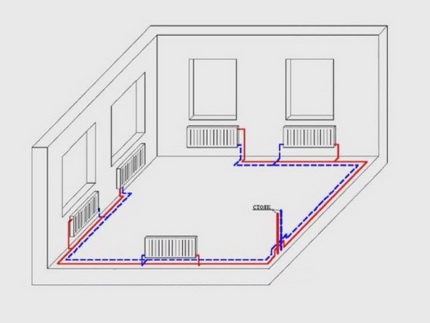
The main drawback of the design is airing. To get rid of him, Maevsky cranes are used. Moreover, if the system is installed in two or more storey buildings, it is assumed that such a crane will have to stand on each battery. This, of course, is not very convenient, therefore, it is recommended to lay special overhead lines that are included in the system.
Such air vents collect air from the heating main and direct it to the central riser. Further, air enters the expansion tank, from where it is removed. Heating circuits with lower wiring and natural circulation are rarely used, because they have a number of limitations. First of all, it is that most of the batteries included in the circuit are finite.
For this reason, they have to be equipped with descenders. If the system has an open expansion tank, then you will have to bleed air almost daily. Installation of air lines looping in the supply pipes makes it possible to level this disadvantage. However, they significantly complicate the scheme and make it more cumbersome. Moreover, the "air" is laid on top of the room.
A significant advantage of the lower wiring, consisting in the absence of a laid main line, is lost. The number of pipes used for installation in this case is quite comparable with the number of parts required for the upper wiring. Therefore, to equip a two-pipe system with a lower wiring, the forced circulation option is most often used.
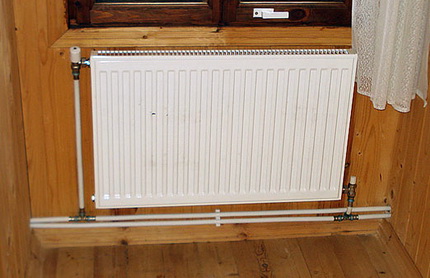
Significant advantages of such a system include:
- Compact placement of the control section of the entire system. Most often it is installed in the basement.
- Reducing heat loss, which gives the laying of pipes on the bottom of the room.
- The ability to connect and operate the heating system until the completion of construction or repair work.For example, the first floor can be heated, and the second will be the necessary work.
- Significant heat savings due to the ability to distribute it in heated rooms.
The disadvantages of the lower wiring include a large number of pipes and accessories required for installation and low fluid pressure in the supply line. In addition, the need for installation can be considered a negative point. Mayevsky cranes heating radiators, as well as the constant removal of air congestion from the system.
Conclusions and useful video on the topic
Video # 1. Review and assessment of the advantages and disadvantages of heating systems with natural and forced circulation:
Video # 2. A detailed analysis of the two-pipe heating scheme for a three-story country house:
Video # 3. How to independently equip a two-pipe heating system in a country house:
The two-pipe type heating system is a widespread method for practical and efficient heating of homes. There are many modifications to this scheme. It is important to choose the best option for your home and make a competent calculation of all system parameters. Only then the house is guaranteed to be warm and comfortable.
Interested in the topic of the article, do you want to understand the unclear points? Have questions or want to share valuable experience? Please write comments in the block below the text.

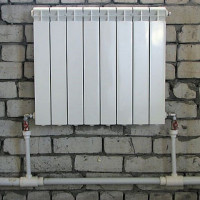 One-pipe heating system of a private house: schemes + an overview of the advantages and disadvantages
One-pipe heating system of a private house: schemes + an overview of the advantages and disadvantages 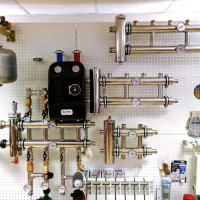 Natural circulation heating system: common water circuit designs
Natural circulation heating system: common water circuit designs  How the radial heating system works: schemes and wiring options
How the radial heating system works: schemes and wiring options 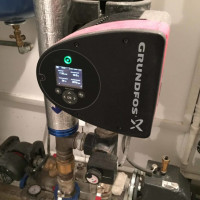 Compulsory circulation water heating system: schemes, implementation options, technical details
Compulsory circulation water heating system: schemes, implementation options, technical details 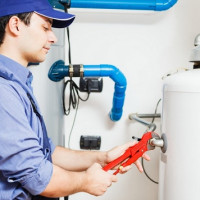 Open heating system: schematic diagrams and features of the arrangement
Open heating system: schematic diagrams and features of the arrangement  How much does it cost to connect gas to a private house: the price of organizing gas supply
How much does it cost to connect gas to a private house: the price of organizing gas supply  The best washing machines with dryer: model rating and customer tips
The best washing machines with dryer: model rating and customer tips  What is the color temperature of light and the nuances of choosing the temperature of the lamps to suit your needs
What is the color temperature of light and the nuances of choosing the temperature of the lamps to suit your needs  Replacement of a geyser in an apartment: replacement paperwork + basic norms and requirements
Replacement of a geyser in an apartment: replacement paperwork + basic norms and requirements
An interesting water supply system, wisely invented. I just have a problem in my house - in one of the rooms there are always cold radiators. This is despite the fact that in the room closest to the boiler, it is impossible to grasp the radiator with your hand: it is so hot. I looked at the wiring diagrams. I think that the lower one is more acceptable for our house. I will put a pump for forced circulation and there will be order.
In order not to freeze when the electricity is turned off, and I have heating with a pump, I combined the forced system with the gravitational one. Pipes with a slope, since the system was originally with a natural type of coolant movement. No batteries installed (large diameter pipes). When frost was cracking outside the window, it was cool in the house, so I decided to embed a circulation device. Now I combine work depending on the external temperature, I turn on the pump only if necessary. Power savings are noticeable.
In the figure “circuit of a two-pipe heating system with forced circulation”, where does the pump pressure go when all the thermostatic heads are closed?
Eugene, the circulation pump does not create pressure as such, it just mixes the water, if you simply say. Otherwise, during its operation in an open type system, water would splash out of the expansion tank.
Michael, you completely struck me, with words about turning on the pump and splashing out water from the expander. To look for such nonsense ...
Let’s start with why, why actually close the thermostatic heads? Maybe you are not completely familiar with the principle of operation of this device of the heating system? Let's figure it out then. And then here people began to give advice, but to argue that everything is wrong. It's time to clarify.
So, for example, take the thermostatic head Icma 28x1.5, but they all have the same operating principle. The operation of the device is based on the compression and expansion of a special internal cylindrical corrugated device, which is filled with process fluid.
To reduce the room temperature, the controller is placed in the appropriate position, the heat-sensitive cylinder expands and presses on the stem of the thermostatic valve. Thus, the valve bore is blocked and the amount of incoming water is reduced. To increase the temperature, the regulator is put in the right position and everything happens exactly the opposite. The point is to close all thermostatic heads, if you can simply turn off the boiler or set it to minimum power, for example.
And the pressure in the heating system is regulated by an expansion tank, this is immediately evident in the diagram.